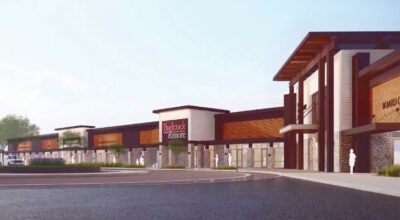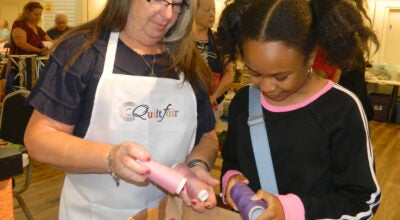N.C. Transportation Museum dedicates new equipment, Lining Bar Gangs exhibit
Published 12:00 am Tuesday, December 1, 2009
SPENCER ó The N.C. Transportation Museum dedicated new pieces of rail equipment, an exhibit honoring an essential part of railroading history and two new additions to the museum grounds as part of its 2009 Family Rail Days activities in June.
“It’s been an exceptional year, as we’re showing off a number of improvements at the museum,” said N.C. Transportation Museum Foundation President Roy Johnson.
The N.C. Ports Authority L-3, the N&W coal hopper No .59159, a Norfolk Southern signal bridge, the N.C. Lining Bar Gangs exhibit and the new West Lead railroad track were all dedicated. A pedestrian bridge on the museum grounds since 1996 was also rededicated following recent improvements.
The Ports Authority L-3 was built by General Electric in 1943. The 45-ton switcher was used by the Ports Authority in Wilmington its entire career to switch freight for shipment overseas. The authority also moved and loaded freight brought in by ship.
Donated by the state of North Carolina in 1980, the L-3 is one of the two oldest diesel locomotives at the museum. Following recent efforts and a $2,000 heritage grant from the National Railroad Historical Society, the L-3 has been restored to the condition in which it was used in the late 1970s.
Jack Salt, chairman of the National Railroad Historical Society Heritage Grant Program, christened the locomotive with a unique alternative to the traditional champagne bottle. He instead broke a Royal Crown Cola bottle filled with water from the Cape Fear River over the L-3. The water comes from the river basin where the L-3 operated for many years. He used the RC bottle because of the drink’s popularity in the eastern part of the state.
N.C. Transportation Museum Volunteers Robin Eanes and Mike Tant painted the locomotive, while a number of other volunteers and master mechanic John Bechtel aided in its restoration.
The Norfolk & Western coal hopper was built in 1940. In the era of steam-powered locomotives, coal accounted for 50 percent to 65 percent of all freight on the railroad. Mined in West Virginia, coal was loaded into these hoppers and shipped to Norfolk, Va., then exported to several factories in North Carolina. The N&W coal hopper was presented to the museum by Norfolk Southern after years of service. Museum volunteers Jim King, Ken Dillon, David Speight and Richard Morse restored, painted and lettered the hopper as it was in 1940.
The Norfolk Southern railroad signal bridge was used to signal engineers that tracks were clear ahead, keeping a proper distance between trains. Signal bridges are essential to prevent collisions due to the distance necessary to stop a train.
Volunteers Doug and Charles Nixon restored and painted the huge metal structure. Museum facilities staff helped position the bridge for restoration while Mid East Railroad Services installed the bridge over the railroad tracks near the museum entrance.
In helping to dedicate the two items, Charles W. “Wick” Moorman, Norfolk Southern chairman, chief executive officer and president, said the railroad is proud to help the N.C. Transportation Museum grow.
“After all, it is a part our heritage,” he said.
Keith Hardison, who heads the Historic Sites division of the N.C. Department of Cultural Resources, referred to the equipment as the “physical legacy” of the state’s transportation history. The “living legacy,” he said, were those gathered to witness Saturday’s dedications.
Moorman also helped dedicate a new railroad track on the museum grounds. Referred to as the “West Lead,” because of its placement on the property, the new track expands the museum’s on-site train ride. A 2006 U.S. Department of Transportation grant allocated $485,335 of the necessary funds for the project. The N.C. Transportation Museum Foundation raised another $121,335 to meet the full cost. Work began in December 2008 and was completed in April. A land lease was also arranged with Norfolk Southern Railroad, as part of the new tracks are located on Norfolk Southern property. With the new design, riders see views of the town of Spencer, the Master Mechanic’s Office and the south end of the property. The return trip features the museum’s Roundhouse and the enormous Back Shop.
“I think the new train ride route improves the visitor experience,” said N.C. Transportation Museum Executive Director Elizabeth Smith. “I hope those that have ridden in the past will return to see the new track.”
Dedicated during Rail Days, the “N.C. Lining Bar Gangs” exhibit opened in February as part of Black History Month. A lining bar gang consisted of a foreman and 10 to 30 laborers or “gandy dancers.” A gandy, also called a lining bar, is used to align track with manual leverage. In order to maintain a fluid motion, many crews sang songs.
Created by museum staff, the exhibit highlights the work and music of the mostly African-American crews using period photos and an audio soundtrack featuring interviews and songs from lining bar gangs.
Michelle Lanier, curator of cultural history with the N.C. Department of Cultural Resources, was a featured speaker at the exhibit’s dedication. Noting the displays of steam and diesel engines, Lanier said the equipment is impressive, but the stories behind the equipment are just as important to preserve.
Also featured at the dedication were members of the Buckingham Lining Bar Gang. The re-enactors perform the songs and work of lining bar gangs. Charles White, who heads the Buckingham Lining Bar Gang, read some of the lyrics used by these hard-working men, such as, “I got a gal on yonder hill/she won’t dance but her sister will.”
The Buckingham Lining Bar Gang also performed twice during Rail Days, showing visitors how the work was done before lining tracks became a mechanized process.
Grant funding for “N.C. Lining Bar Gangs” was provide by Rowan County, the Blanche and Julian Robertson Foundation, the Spencer Woman’s Club and Steven S. Zahniser.
The Transportation Museum also rededicated a pedestrian bridge that connects two parking lots and spans the museum’s railroad tracks, providing an opportunity to watch and photograph trains passing underneath. The bridge has had new decking installed after the original decking installed in 1996 deteriorated over the years.



